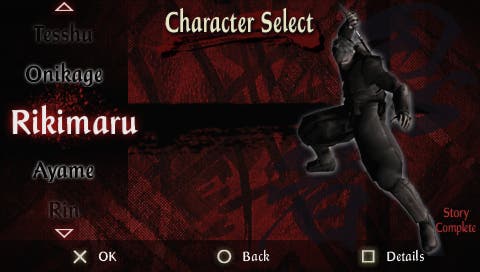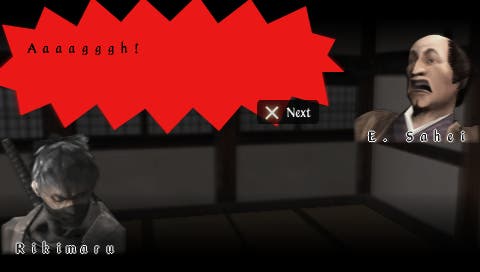Tenchu: Time of the Assassins
Time for the bin, more like.
Oh GOOD, another game set in feudal Japan. Why do developers persist with this? As everyone knows, history is boring and rubbish. Hence you don't see many copies of Grand Theft Auto: Constantinople on the shelves, or Project Gotham Penny Farthing Racing, and you're probably not looking forward to Halo 3000 B.C.
But it seems they just can't resist setting game after game in feudal Japan, confident that the simple addition of a stupid pinball mechanic or giant crab will keep us enthralled. So here comes Tenchu: Time of the Assassins, which doesn't feature pinball or crabs, actually - but does feature ninjas.
To be specific, it features five Tenchu favourites: Rikimaru, Tesshu, Rin and Ayame. A fifth character can be unlocked later, if you can stay awake that long. Each fighter has their own storyline, and each storyline is a load of old cobblers involving disquieting auras, corrupt politicians, filthy spies and the like. Plus, of course, ninjas.
At the start of every mission, you have to select which items to take with you, which is a bit tedious. But not as tedious as the missions themselves, thanks to dull environments, a shoddy camera and uninspiring objectives.
As with the previous Tenchu titles, the main aim of the game is to creep around without alerting the attention of your enemies, pausing to stab them where necessary. There's a little icon on the bottom left of the screen which shows how wary any nearby opponents are - if it shows a bit of fire and two exclamation marks, you're about to have a fight.
And chances are, it'll be rather a frustrating one - not because your enemies are particularly skillful, but because the camera is particularly rubbish. It displays no logic in following the action, so if your enemy disappears off the screen for a moment there's no way of knowing what he's up to or which side he's about to attack you from next. You can control the camera by holding down both the shoulder buttons and using the analog nubbin to move it around ve-ry-slowww-lyyy, but as you might imagine this isn't always easy to do when you're in the middle of a battle.
Hammer time

The control system is pretty simple - you press one button to defend and another to attack, and you hammer the attack button to pull off combos. You can lock onto a specific enemy by holding down the left shoulder button, but for some inexplicable and completely stupid reason, you can't jump while you're doing this.
So chances are, you'll want to avoid fights wherever possible, using your stealth skills to creep around undetected. But unfortunately, the stealth system doesn't work well enough either. True, you can attempt to get through levels by skipping across rooftops, aided by your grappling hook, which is quite cool. But eventually you'll have to do a bit on foot, which is where the problems set in.
Let's say you're creeping around (again, ve-ry-slowww-lyyy) and the icon alerts you to the fact that an enemy is nearby. So, you back up against a wall - only to find that the camera is now focused entirely on your character, and you can't see who's approaching or from which direction. Far too more often than not, by the time you've pressed both the shoulder buttons and started hauling the camera around it's too late - the enemy is upon you and you've got a chest full of steel to prove it.
So you'll probably find it saves time and blood to simply run about a bit until you spot the enemy, which sort of defeats the point of the whole stealth thing. It also means you'll get a lower rating at the end of the level - which will arrive quickly in most cases, since they're very short.
They're even shorter if you use the map, which displays the full layout plus, often, the location of the end point. There are rarely any tricky obstacles in your path - it's just a case from getting to A to B. For example, one of the missions can be completed in minutes just by wandering around a bit, defeating three enemies, and killing a cat (it might have been a wolf, actually. But if so it was a rubbish one).
Environmental issues

You can choose not to use the map, of course - but then you'll find yourself wandering aimlessly through some of the dullest environments ever. They're generally sparse, poorly lit and grey. Grey, grey, grey. If this game is based on historical fact, it would appear that feudal Japan bore a striking resemblance to Croydon, only with shorter buildings and less vomit on the pavements. And possibly even less ninjas.
When environments aren't busy being grey, they're hard at work being black. Bizarrely, you can usually only see a few steps in front of you at any time - beyond that, there's just a black void behind which lurks who knows what terrors and dangers. The experience is much akin to standing at the door of the Blue Orchid in Croydon, in fact. Again, this makes it very difficult to see what lies ahead and prepare yourself accordingly.
If the environments don't bore you, the endless on-screen text conversations certainly will. Some of them seem to take as long as the actual missions themselves, and although the translation isn't too bad, you'll rarely receive any interesting or useful information.
There are some animated cutscenes, but not a lot, which is probably a good thing - since although they do feature decent enough graphics, the script and American voiceovers are terrible. It's hard to feel like you're actually playing a game set in feudal Japan when characters are inclined to spout things like, "Sheesh, I'm just gonna take a piss, okay?".
Environmental issues

When you inevitably get bored of the single player game, you could give the multiplayer mode a try - we couldn't, since they only sent us one copy. Then there's the mission editor, which features options aplenty. You can create a normal, versus or co-op mode, lay out the terrain, select which enemies appear, choose from a variety of objectives and even write the introductory text.
Which is probably great if you like that sort of thing; not so much if you think that being presented with a mission editor in a rubbish game is a bit like going to a restaurant, getting served a plate of dog eggs and being proudly informed that you can eat them in whatever order you wish.
The point is, Tenchu: Time of the Assassins is very much a plate of dog eggs. Big crusty old white ones. Neither the stealth nor the combat systems work properly, and the missions are uninspiring and over too quickly. The presentation leaves far too much to be desired, what with dull, sparse environments where you can only see a few feet in front of you, tiresome text conversations and a dreadful camera. There's not even an in-game tutorial, for goodness' sake - just 31 whole pages of text to scroll through.
Good points? Well, the music is all right. In a sort of Japanese Riverdance as performed by Tracy Chapman kind of way. And enemies' abdomens spurt open nicely when you slice them up. Frankly, that's about it. The Tenchu series has been around for far too long - perhaps since Japan was all feudal, or at least it feels that way - and now it's time to say goodbye. Not even a giant crab could save this one.








